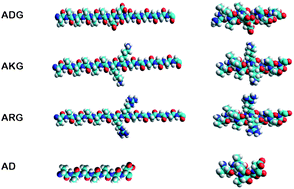Structures of self-assembled amphiphilic peptide-heterodimers: effects of concentration, pH, temperature and ionic strength†
Abstract
The amphiphilic double-tail

* Corresponding authors
a
Department of Chemical and Biological Engineering, Chalmers University of Technology, Gothenburg, Sweden
E-mail:
Norden@chalmers.se, Zhongliluo@163.com
Fax: +46 31 772 3858
Tel: +46 31 772 3041
b Center for Biomedical Engineering and Center for Bits and Atoms, NE47-379, Massachusetts Institute of Technology, Cambridge, MA, USA
The amphiphilic double-tail

 Please wait while we load your content...
Something went wrong. Try again?
Please wait while we load your content...
Something went wrong. Try again?
Z. Luo, B. Åkerman, S. Zhang and B. Nordén, Soft Matter, 2010, 6, 2260 DOI: 10.1039/B926962B
To request permission to reproduce material from this article, please go to the Copyright Clearance Center request page.
If you are an author contributing to an RSC publication, you do not need to request permission provided correct acknowledgement is given.
If you are the author of this article, you do not need to request permission to reproduce figures and diagrams provided correct acknowledgement is given. If you want to reproduce the whole article in a third-party publication (excluding your thesis/dissertation for which permission is not required) please go to the Copyright Clearance Center request page.
Read more about how to correctly acknowledge RSC content.
 Fetching data from CrossRef.
Fetching data from CrossRef.
This may take some time to load.
Loading related content
